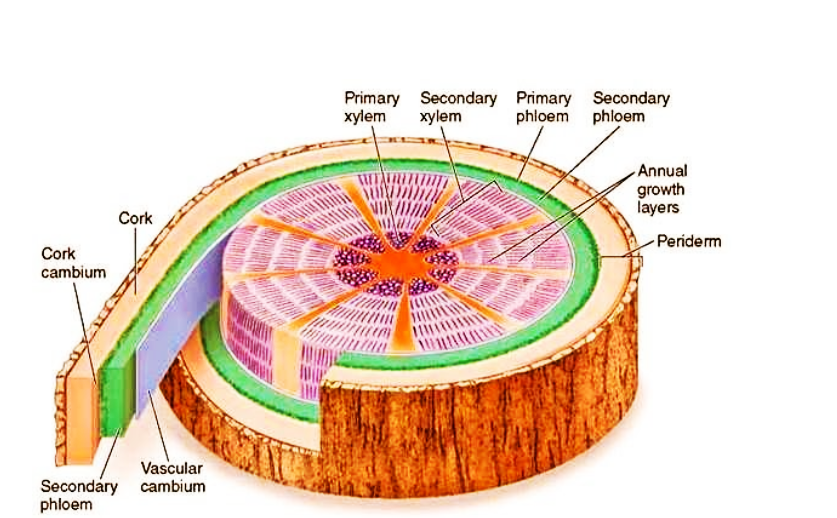
Answer
467.4k+ views
Hint: They are the characteristic of woody trees having conducting tissues which help in the movement and transportation of water and nutrients mainly carbohydrates.
Complete answer
Annual rings are the concentric circles that are formed by the trees every year. These annual rings show the amount of wood produced during one growing season of the tree. The annual rings are the xylem tissue which helps in the formation of the stem in woody plants.
Additional information
- Annual rings are the visible criss-cross regions in the woody stems or tree trunks.
In each year a layer of xylem is produced by the periodic activity of the cambium layers present in the tree.
- The vessels of xylem are large and thin-walled during spring and are smaller and thick-walled during the summer season.
- These large and small vessels will have a different way of conduction resulting in light and dark rings.
- The annual rings are of two types:
So, the correct answer is ‘Layers of secondary xylem in a stem’.

Note: The scientific method of finding the age of the tree or the year in which it was formed is known as dendrochronology. The term dendrochronology was derived from the Greek word dendron meaning “tree”, Kronos meaning “time”, and logia meaning “the study of”. The vascular bundles in monocot stems are found to be scattered while the vascular bundles in dicot stems are found to be arranged in a ring-like manner.
Complete answer
Annual rings are the concentric circles that are formed by the trees every year. These annual rings show the amount of wood produced during one growing season of the tree. The annual rings are the xylem tissue which helps in the formation of the stem in woody plants.
Additional information
- Annual rings are the visible criss-cross regions in the woody stems or tree trunks.
In each year a layer of xylem is produced by the periodic activity of the cambium layers present in the tree.
- The vessels of xylem are large and thin-walled during spring and are smaller and thick-walled during the summer season.
- These large and small vessels will have a different way of conduction resulting in light and dark rings.
- The annual rings are of two types:
> Springwood – is present at the beginning of an annual ring formed in favorable conditions. It has numerous thin xylem vessels undergoing more activity and is lighter in color. It is also called earlywood.
> Autumn wood – it is present at the end of an annual ring in unfavorable conditions. It has less and thick vessels that undergo less activity and are darker in color. It is also called as latewood.
So, the correct answer is ‘Layers of secondary xylem in a stem’.

Note: The scientific method of finding the age of the tree or the year in which it was formed is known as dendrochronology. The term dendrochronology was derived from the Greek word dendron meaning “tree”, Kronos meaning “time”, and logia meaning “the study of”. The vascular bundles in monocot stems are found to be scattered while the vascular bundles in dicot stems are found to be arranged in a ring-like manner.
Recently Updated Pages
Who among the following was the religious guru of class 7 social science CBSE

what is the correct chronological order of the following class 10 social science CBSE

Which of the following was not the actual cause for class 10 social science CBSE

Which of the following statements is not correct A class 10 social science CBSE

Which of the following leaders was not present in the class 10 social science CBSE

Garampani Sanctuary is located at A Diphu Assam B Gangtok class 10 social science CBSE

Trending doubts
Which are the Top 10 Largest Countries of the World?

Fill the blanks with the suitable prepositions 1 The class 9 english CBSE

How do you graph the function fx 4x class 9 maths CBSE

Find the value of the expression given below sin 30circ class 11 maths CBSE

In what year Guru Nanak Dev ji was born A15 April 1469 class 11 social science CBSE

The Equation xxx + 2 is Satisfied when x is Equal to Class 10 Maths

Why is there a time difference of about 5 hours between class 10 social science CBSE

Difference between Prokaryotic cell and Eukaryotic class 11 biology CBSE

What is BLO What is the full form of BLO class 8 social science CBSE




